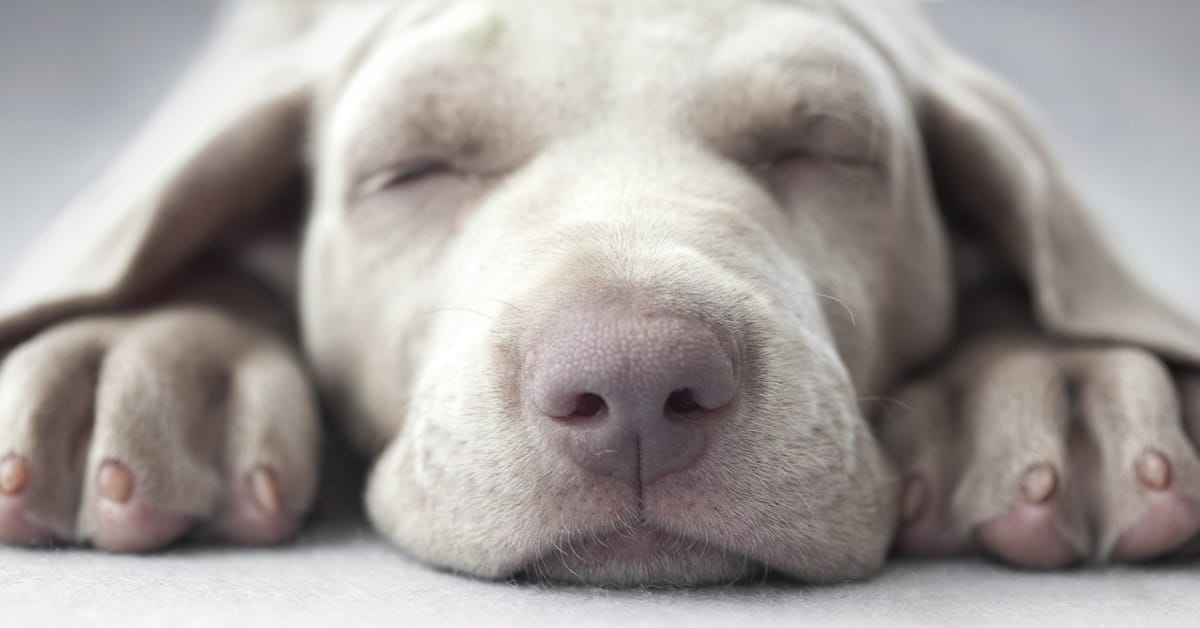Is your dog sleeping right now? If so, is it a gentle sleep, or are they sleep twitching? For example, my friend’s rescue pup naps away, paws hanging off the couch, and then her paws jerk, and she starts paddling the air like she’s chasing frisbees. Why do dogs twitch in their sleep like that?
It’s cute to watch. But as pet parents, you probably have questions. You might wonder what your dog dreams about. Are those muscle twitches the result of frisbee-catching dreams or something else? Do dogs even dream as we do?
As it turns out, there are a lot of similarities between the brain activity of dogs and humans.
Dogs Have Sleep Cycles Too

One person who’s conducted neuropsychological research on the brain activity of dogs is Dr. Stanley Coren. He’s a professor emeritus of psychology at the University of British Columbia the author of “Do Dogs Dream? Nearly Everything Your Dog Wants You to Know” (Norton, 2012).
In this interview for Live Science, Dr. Coren says both dogs and people have a sleep cycle. Like the human sleep cycle, your dog’s sleep relates to the brain waves and moves through three distinct cycles.
The three stages of dog sleep are:
- NREM: Non-Rapid Eye Movement
- REM: Rapid Eye Movement
- SWS: Short Wave Sleep
You’ve probably heard of REM sleep. This is the stage where you’re most likely to see your dog’s eyes moving under their lids. This is also when your dog is most prone to muscle twitches, paddling paw movements, whimpers, and, yes, dreams.
According to neuropsychological research, NREM sleep is the early stage of sleep. Your dog’s body relaxes, and the brain waves change. Researchers use a variety of methodologies to study canine sleep, including observation and electroencephalogram (EEG.) The EEG is when the pooches have electrodes attached to their heads to monitor brain activity.
Why do dogs twitch in their sleep?
So, why do dogs twitch in their sleep? It’s a natural part of the REM stage. The REM cycle then is usually the dream cycle, and SWS is the period before waking.
At each stage of the sleep cycle, the brain waves change. You can learn to tell what stage of sleep your pooch is in by their body language. Does your pup look relaxed? Are your dog’s eyes moving under the lids? Do you hear little yelps and muscle movements? Those indicate REM sleep, and your pup is likely deep in dreamland.
During REM sleep, it’s probably best to not wake your dog up. Let sleeping dogs lie because if you wake them unexpectedly, they could startle. Some dogs are known to nip and be aggressive when they’re woken from REM sleep, so if you need to wake them, it is better to call their name or make other sounds.
Mammals Dream

While the study of dogs and dreams is a newer endeavor, scientists believe that all mammals dream. Scientists studied the brain activity in rats as they ran through a series of mazes. When the rats curled up for a snooze, their brain activity showed spikes similar to humans indicating a dream state. It’s the same for dogs.
The brain stem has a section called the pons. It’s a small part of the brain that looks a bit like a protrusion in the brain stem. The pons is something of a communication hub because it allows messages to travel to and from the brain. It controls muscle twitching.
The word “pons” is Latin for bridge. It was named by an Italian anatomist who believed the section connecting the right and left hemispheres of the brain looked like a bridge. Not being an anatomist, it looks a little knobby to me, but the name stuck.
How Much Does a Dog Sleep?
Adult dogs sleep an average of 10.8 hours a day though it can be as much as 13 hours. Puppies can sleep much more. As you may guess, it’s typical for a dog’s sleep cycle to change throughout their lives. For instance, growing puppies and senior dogs tend to sleep the most.
Watching your dog sleep, you may notice their muscle twitching and rapid eye movements during dream time. Dog dreams can be short, only lasting a minute or so though it depends on their size. Larger dogs dream for longer, while small dogs may have dreams lasting only thirty seconds.
Sleeping Helps Dogs Learn

Scientists have long studied the effects of sleep on our memories and learning retention. Giving your brain a rest, aka, sleeping, helps your brain absorb new information and consolidate it in your mind.
It turns out, sleeping benefits your dog’s brain too. A Hungarian scientist conducted two studies on dogs and their short-term and long-term memories. The participants were pet dogs, and all knew the Hungarian commands for “sit” and “lie down” and other commands.
The first study hooked electrodes to the dog’s scalps to monitor their brain activity as they learned something new. In this case, understanding the English words for “Sit,” “Lie down,” etc. (Don’t worry, the study only included willing pets and their pet parents.)
The scientists wanted to see if napping helped the dogs learn these commands easier for the second study. The pups took a three-hour snooze and then were re-tested when they awoke. In general, they performed better after the nap.
However, scientists were excited even in the first study because they could see wave patterns in the non-REM sleep cycle. In this non-dream stage, the dog’s brains increased in what’s called “delta power.” Humans have this “delta” power too.
Scientists believe that these brain waves indicate a connection between sleep and learning in the brain. You know it’s essential to get that rest!
What Do Dogs Dream About?

Since dogs and people go through similar sleep stages and have similar brain waves, scientists believe dogs also dream as we do. If your dog could tell you his dreams, you might hear about trips to the dog park and snuggling on the couch. Just like we often dream about everyday things, it’s likely the same for your dog.
We can only imagine what goes through our pup’s brain. But what if dog twitching seems more serious than a simple dream? What if the paddling paws stretch out stiff and your dog is awake? Could your dog be having a seizure?
What’s the difference between harmless muscle twitching and seizures?

While it’s common for your dog’s body to twitch in sleep, seizures are a different matter. Seizures tend to last longer and be a little more violent than normal sleep twitching. They also tend to happen when your dog is conscious or on the verge of sleeping.
Sometimes, your dog will know they’re coming and act nervous before a seizure. Dog owners who’ve seen seizures know they’re scary and erratic. Your dog might panic or act nervous or confused leading up to the episode and after.
If your dog has repeated seizures, it may be epilepsy. You’ll want to talk with your vet about epilepsy symptoms and treatments if that’s the case.
Zzz …

Now that you know your furry friend has sleep cycles and sleep twitches in their sleep like people, does that make them even cuter for you? Do you like knowing they have a part of the brain that helps them learn and dream?
To get your pup the optimal resting place, check out Best Friends by Sheri calming dog beds, pet huts, and more. To help you out, we have a blog post that breaks down each type of pet bed.

